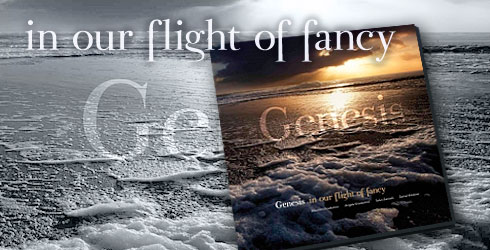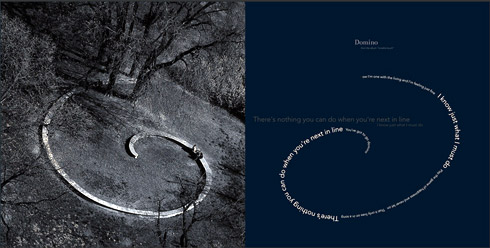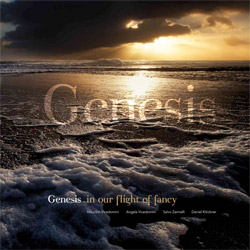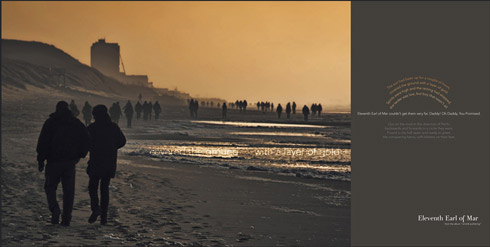


In one of his novels Peter Handke describes the dilemma of a goalkeeper who faces a penalty: Should he jump? To the left or the right, high or low, far or short? Handke’s goalie stands still and thus saves the penalty. Editors of coffee-table books face a very similar problem. They want to present a certain subject in images, and because there is a limited amount of space even in a large book they have to make a choice. Do we show Roman architecture in a long shot or point out the details? The selection of photos is by definition arbitrary and depends on the taste of the authors. They have to trust in their own taste and hope their choice is right. Like Handke’s goalie they only have a small chance to call the ball, i.e. to hit the taste of the public. Most coffee-table books benefit if the authors go and stand by their personal choice. It may not be to everyone’s liking, but it certainly is honest and authentic.

A new publication called Genesis In Our Flight Of Fancy
lies before me on the table. The poetic blurb on the back describes it
„a tribute not only to the music and lyrics of Genesis but also to their
significance to the authors' lives.“ That may prove a problem, for how
could one truly understand what the other feels in a piece of music? We
will see. The cover image promises high-quality photographies. The large
format of the book (30x30cm) help make the images look good on the
heave matte paper.
Prefaces are like the overtures of a book. This one has an art
history professor who (probably thinking of Shakespeare) calls the
photographers „jesters who evoke the music of Genesis through images of
a magic, mystical world“. He also praises the visual designer and the
layout who „brings a striking touch to the layour and graphics of each
page“. Mario Giammetti, the head of the Italian Genesis Fanclub Dusk,
adds his voice and describes brilliantly what Genesis fans of all places
and times have in common. Steve Hackett calls the photos as
masterpieces that capture the essence of Genesis lyrics (his handwritten
note is carefully reproduced on one page). The best advice for the book
is given by its designer Daniel Klöckner: „reach that place within you
that perceives without thinking, allowing you to simply experience.“
Having turned to the first combination of images and text the
reviewer is pleasantly surprised. The photos are real eye-catchers, but
they are not the dominant element on this double page. There is in fact
not central element to which everything else is subordinated; image and
text areas are in a very delicate balance; giving more weight to the one
would not only harm the other but the overall effect. Each double page
has its own layout, the “standard layout” (i.e. a central image with the
text in small black print in the corner) is happily and carefully
avoided. Though the lyrics use the same font throughout the book, it
varies in size, colour and shape. Sometimes the letters follow an arc
that has begun in the image, sometimes they are distributed across the
page as if a speaker wanted to give a visual impression of their
intonation; single words or lines are frequently printed in a different
colour, thus providing a new sense in the lyrics. Daniel Klöckner, the
visual designer, has done a truly excellent job here.
The surprise is pleasant for another reason, too: The first
combination of image and text is already so strong that it forces the
reader to abandon their own ideas for a while and get into the relations
between these images and these lines. The photos never fulfill
conventional expectations; the first double page quote a few lines from Squonk,
but the photo does not show a cute (or even ugly) furball but a much
rougher reality. The links between the lyrics and the images are clear,
though never obvious to the point of triviality. They urge the reader
not only to see but actively to discover the connections: Images and
words turn into food for thought.
The lyrics extracts in this book are lifted form songs that were released on studio albums from A Trick Of The Tail up to and including Calling All Stations. Some songs were used several times, others left out altogether. Every album (except for Calling All Stations, Abacab and the self-titled album)
has eight double pages assigned on average. There are no lyrics from
before 1976; otherwise it would apparently have taken much longer to get
the approval the authors sought from the band. On the one hand it would
certainly have been interesting to see which images the authors have
found for the rather bizarre lyrics from the Gabriel era, but on the
other hand some of the photos now included in the book would have had to
be dropped to make space for Gabriel-era lyrics and images. Perhaps
there will be a second volume…
 Even
if you exclude the bizarre stories from the Gabriel era the lyrics of
Genesis are frequently described as somewhat removed from reality. Apart
from love’s labours won and lost the lyrics often deal with histories
that are fictitious or long part (Eleventh Earl Of Mar), peculiar animal stories (Squonk, All In A Mouse’s Night) or strange encounters of the third kind (Keep It Dark). The photos in this book haul the lyrics back from fiction to reality (or vice versa). The first line of One For The Vine is accompanied by the photo of a military cemetery – a most ghostlike bride stands in front of the Second Home By The Sea.
Photos and lyrics have been combined in good taste; they never go for
the cheap surprise effect, but demand that the reader get involved. It
is not a difficult task, and it does increase the pleasure of this book.
Even
if you exclude the bizarre stories from the Gabriel era the lyrics of
Genesis are frequently described as somewhat removed from reality. Apart
from love’s labours won and lost the lyrics often deal with histories
that are fictitious or long part (Eleventh Earl Of Mar), peculiar animal stories (Squonk, All In A Mouse’s Night) or strange encounters of the third kind (Keep It Dark). The photos in this book haul the lyrics back from fiction to reality (or vice versa). The first line of One For The Vine is accompanied by the photo of a military cemetery – a most ghostlike bride stands in front of the Second Home By The Sea.
Photos and lyrics have been combined in good taste; they never go for
the cheap surprise effect, but demand that the reader get involved. It
is not a difficult task, and it does increase the pleasure of this book.
There are three combinations of images and lyrics in this book
that cannot draw the reader into their context: The motives used for the
Mama lyrics and one of the Entangled quotes have already occurred elsewhere in the world of Genesis, and while the photo that accompanies In That Quiet Earth
is an excellent choice one cannot help but think that “this does look
exactly like…”. Most of the photos show what the photographer had in
front of their lens. Some of them are posed, and there is nothing to be
said against that. A few photos were changed by montages, indeed so
obvious montages that they disturb the overall effect of the photo.
Since all other photos are such an excellent quality, one has to assume
that the manipulations were meant to be visible – that the disturbing
effect is intended.
A good book gently guides the reader to the end. Some
coffee-table books do not take the issue seriously and kick out the
reader with the simple revelation that there are no more pictures. The
book in hand does an excellent job with that. We do not want to reveal
too much, so we will only say that Guide Vocal
introduces the end. Pay attention to those lyrics and then mark which
lyrics accompany the photos on the pages after that. This is very
intelligent and very subtle. At the very end the book urges the reader
again to “better think awhile”.
A brief appendix lists where the lyrics were taken from. It
would have been great if the authors had also added where the photos
were taken. The image for “Go West young man” becomes all the more
potent if you know (as you can, incidentally, find out from the preface)
that this is not any old beach.

With their book Genesis In Our Flight Of Fancy photographers Maurizio and Angela Vicedomini, Salvo Zannelli and visual designer Daniel Klöckner invite us on a journey through the lyrics of Genesis and show us what they have found there. These are all new points of view and bold associations we are offered here. Even with our own images of the lyrics in our heads one thing is certain: Everything in this book is coherent, consistent, almost palpable. However you choose to read the lyrics, this is a book that combines a large number of extraordinarily well-done and frequently beautiful photos that were inspired by the lyrics of Genesis. Genesis In Our Flight Of Fancy is a personal, and very pretty homage to Genesis and their lyrics.
by Martin Klinkhardt
